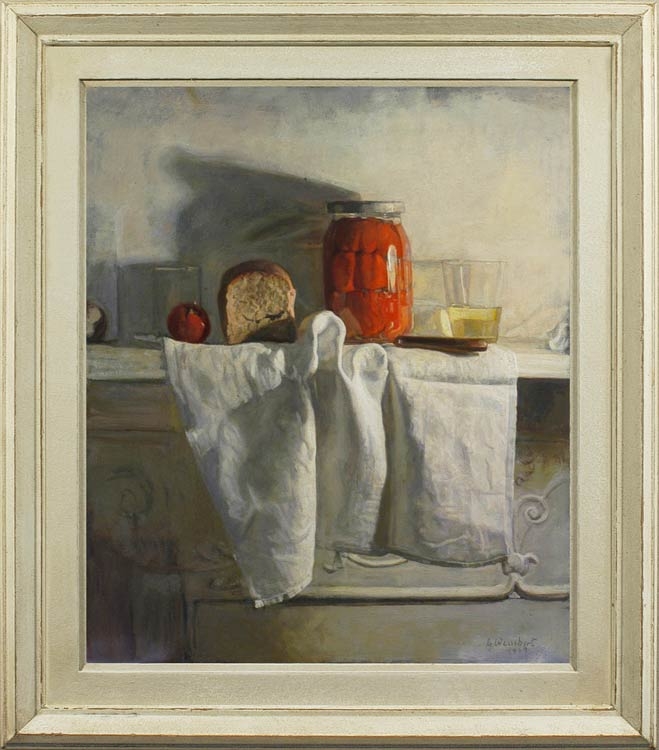This is one of the most attractive of Weissbort’s still life paintings; an extraordinarily subtle harmony of neutral shades – the painted decorative shelf, the crumpled swathe of white linen, the pearl grey background, the transparent glass, the gentle fawns and browns of bread and knife handle: all animated by the intense glow of the off-centred red peppers and the balancing darker red of the tomato. He has painted a very plastic, three-dimensional study which is at the same time a carefully-composed pattern of abstract shapes, given added force by the restricted palette. This use in still life arrangements of neutrals lifted by one more vivid note is a reminiscent of the work of artists such as Giorgio Morandi (1890-1964), the father of the minimalist still life painting; William Nicholson; or Samuel Peploe.
Biographical details
George Weissbort (1928-2013) was born in Belgium and moved to London at the age of 7. He attended the Central School of Art & Design (now St Martin’s) where he was taught by Ruskin Spear and Rodrigo Moynihan. He was influenced by Arthur Segal to move from the abstract expressionism of the 1940s to realism, and by Bernard Meninsky, who taught life drawing at the Central School, to study the Old Masters. He turned first to artists such as Cézanne and Matisse, and later to Vermeer, Chardin, Velasquez, Corot, Titian, Holbein, and Piero della Francesca, amongst others.
He exhibited regularly at the Royal Academy, the Royal Society of Portrait Painters and the Fine Art Society. In 1964-65 he had a large exhibition in Paris, and in 2006 he had a one-man retrospective at the Chambers Gallery, London, followed in 2008 by another at the Denise Yapp Gallery, Whitebrook, Monmouth.
He wrote essays on art and criticism which look both at the techniques of making a painting, and of appreciating a work of art. The latter skill he believed came only after years of consciously training the eye to see as the artist saw, considering for example the ‘negative’ spaces around and between objects. He also discussed the work of specific artists, such as Lucien Freud and Vermeer.
His obituary in The Independent quotes Brian Sewell, a friend, as saying of him that Weissbort ‘painted the right pictures at the wrong time’. His appeal was to those who understood his models and influences; he could be described as a painter’s painter, and the same obituary quotes Paula Rego describing him as ‘a truly honest artist who knows so much about painting’.
Publications: George Weissbort, Paintings and Drawings (Parnassus, 2008), ill. 130 colour plates; includes transcripts of a filmed interview; essays by Tony Rudolph, David Lee and Bernard Dunstan RA.
YouTube video: A tribute to George Weissbort by John French.


